Abstract
1. The influence of graded parasympathetic and sympathetic nerve stimulations on the secretion of protein from rat submandibular gland was studied. Peroxidase was used as a marker for the acini and rat tissue kallikrein (official nomenclature rK1) as the marker for granular ducts. Tonin (rK2) was also measured, and the ratio of rK2:rK1 was calculated as an indication of the cellular route of secretion. 2. Continuous parasympathetic nerve stimulation caused a copious flow of saliva that had a low protein content. The secretion of peroxidase (acini) showed a gradual moderate increase as the frequency increased. However, the concentrations of rK1 and rK2 (granular ducts) showed little change throughout, and the ratio of rK2:rK1 remained relatively constant. 3. Graded sympathetic stimulation was applied against a background of parasympathetic stimulation. Secretion of peroxidase was increased by the addition of 0.1 Hz continuous sympathetic stimulation. The amount increased thereafter up to 2 Hz, but showed no further increase if the stimulation was applied as bursts of 10 or 20 Hz. In comparison, the secretion of proteinase activity showed little change with superimposed continuous sympathetic stimulation, and the rK2:rK1 ratio was similar to that in saliva produced by parasympathetic stimulation alone. Sympathetic stimulation applied in bursts, however, caused a large increase in the secretion of proteinase activity, and with 20 Hz burst stimulation the rK2:rK1 ratio was indistinguishable from that of sympathetic saliva per se. There was an augmented secretion of both peroxidase and kallikrein when 20 Hz burst stimulation was combined with parasympathetic stimulation. The effects of sympathetic stimulation were abolished by alpha- and beta-adrenoceptor blockade.(ABSTRACT TRUNCATED AT 250 WORDS)
Full text
PDF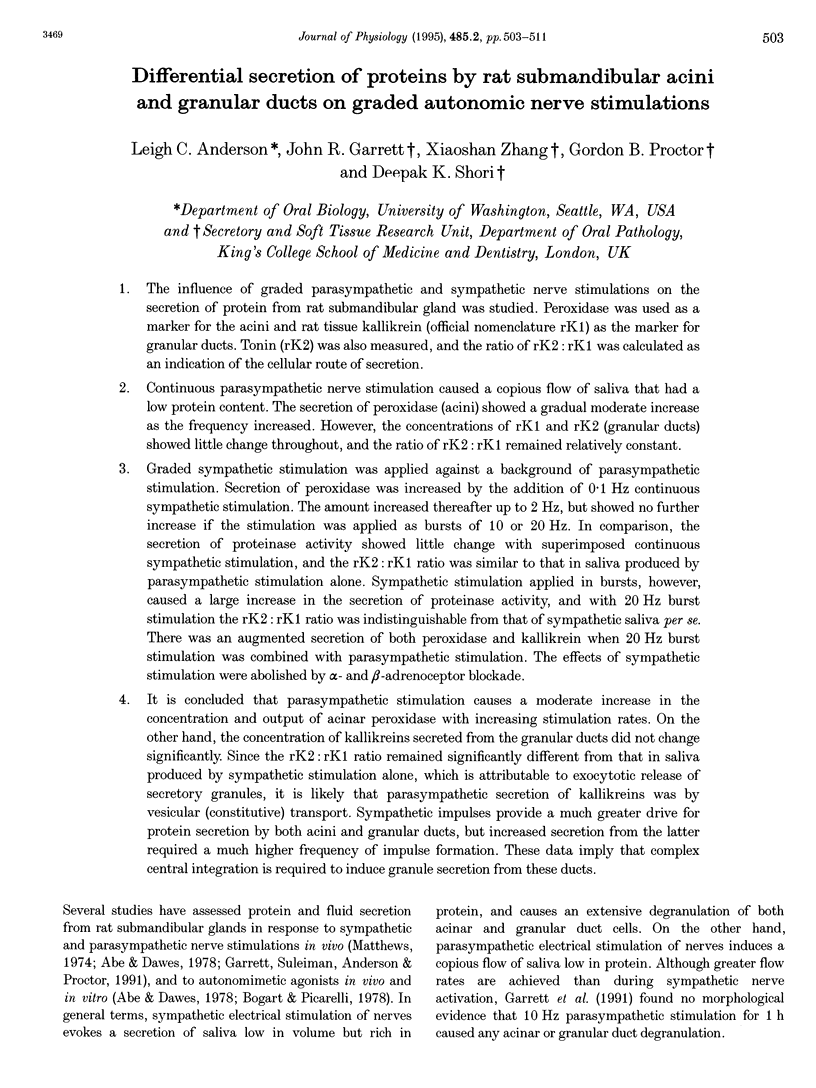

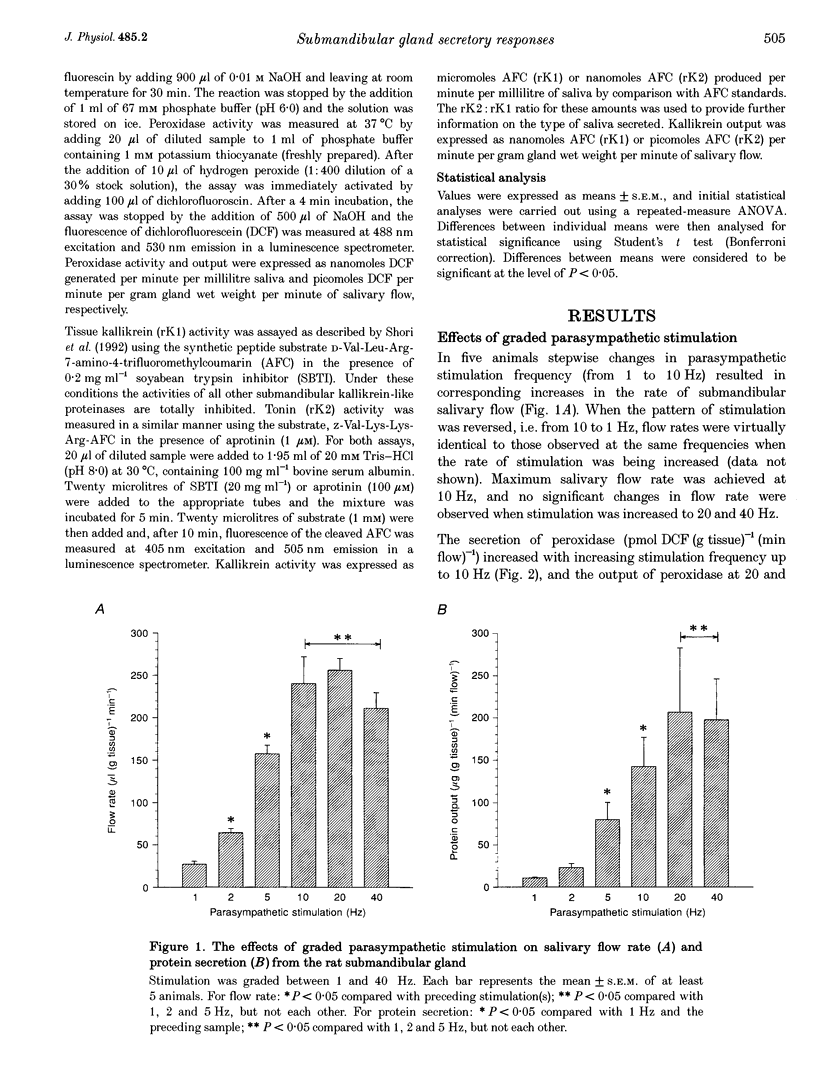
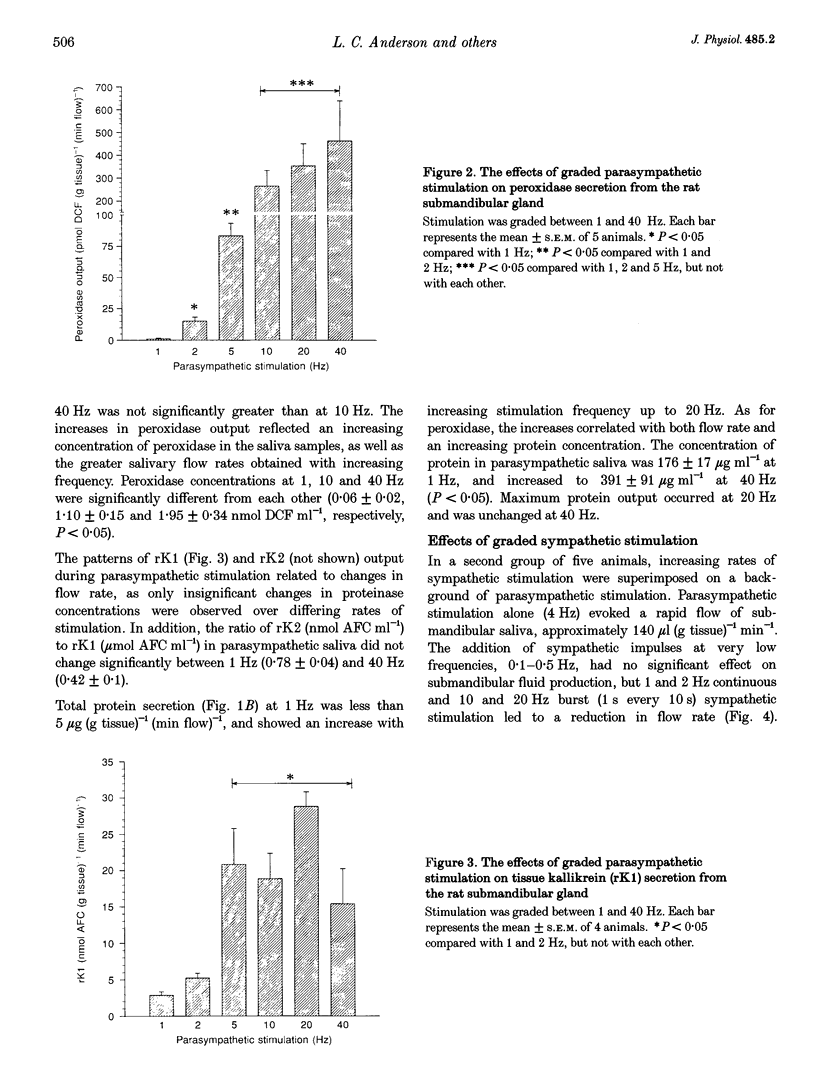
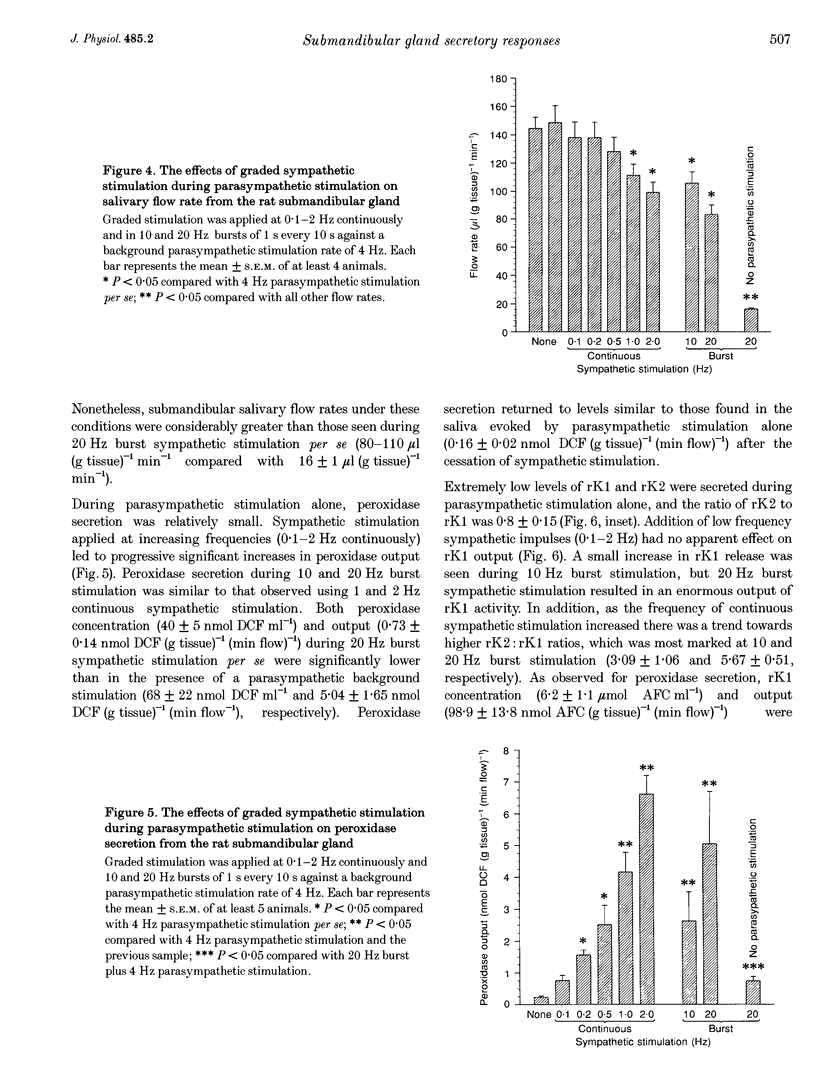


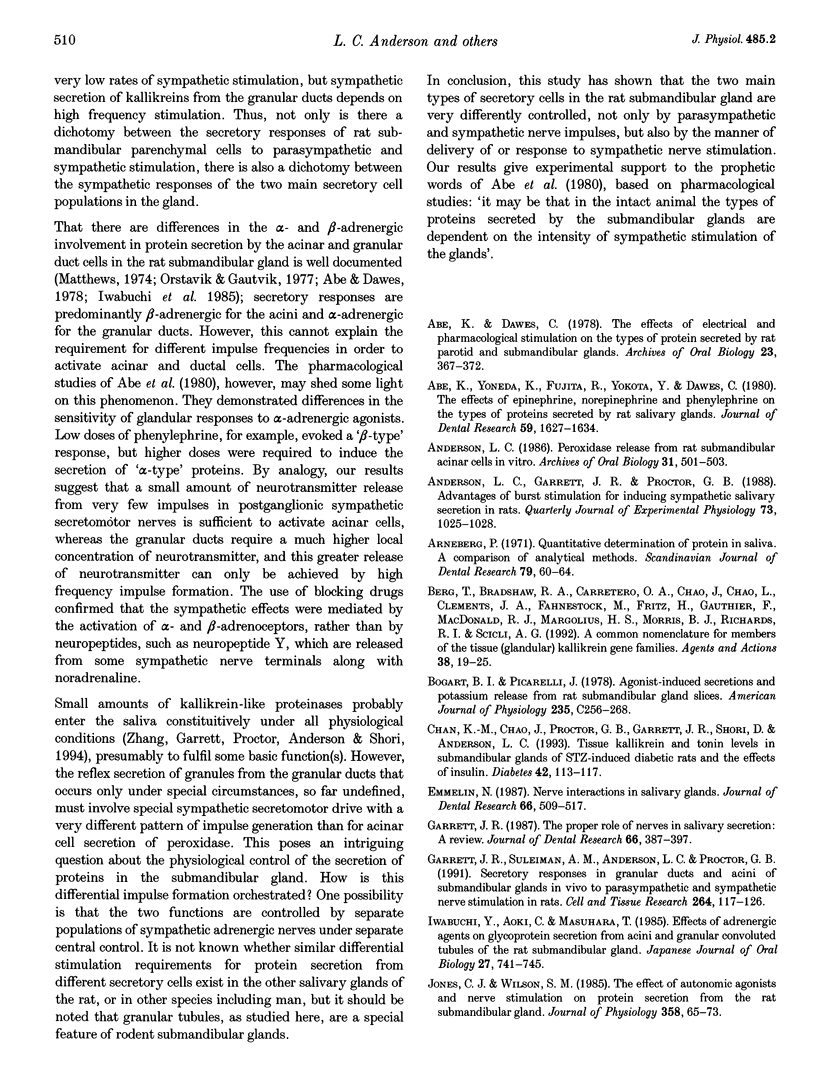
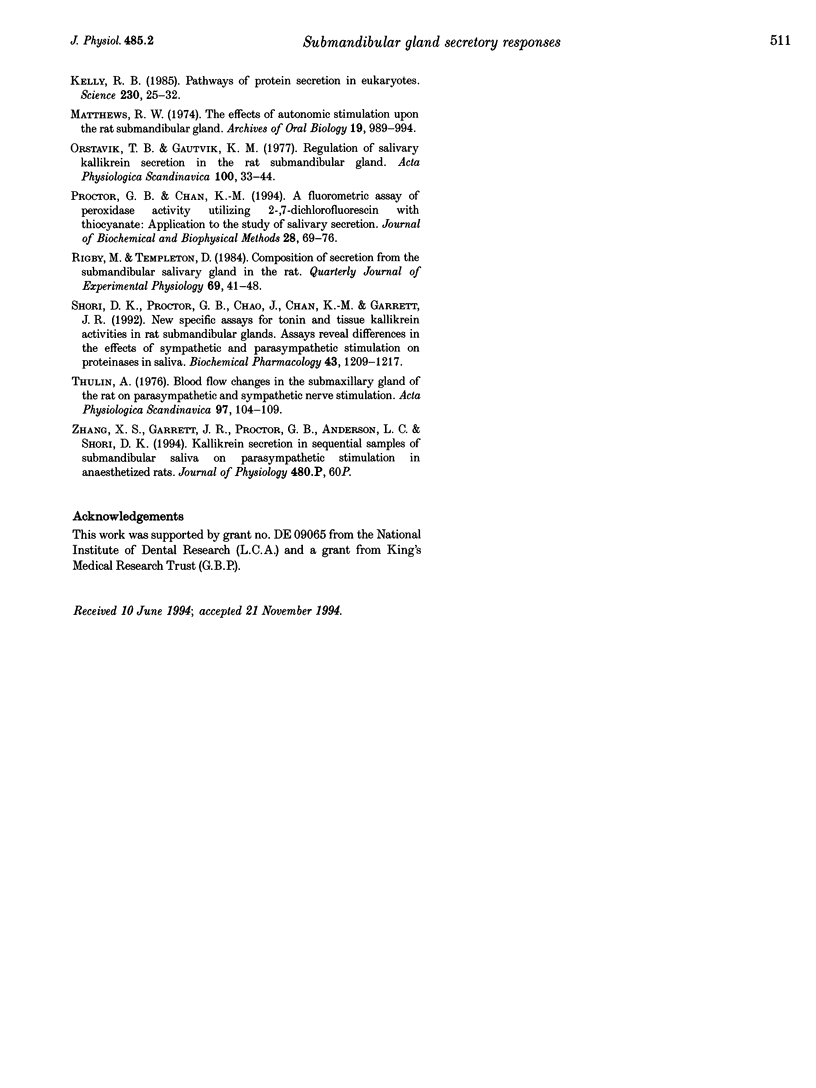
Selected References
These references are in PubMed. This may not be the complete list of references from this article.
- Abe K., Dawes C. The effects of electrical and pharmacological stimulation on the types of proteins secreted by rat parotid and submandibular glands. Arch Oral Biol. 1978;23(5):367–372. doi: 10.1016/0003-9969(78)90094-8. [DOI] [PubMed] [Google Scholar]
- Abe K., Yoneda K., Fujita R., Yokota Y., Dawes C. The effects of epinephrine, norepinephrine, and phenylephrine on the types of proteins secreted by rat salivary glands. J Dent Res. 1980 Oct;59(10):1627–1634. doi: 10.1177/00220345800590101201. [DOI] [PubMed] [Google Scholar]
- Anderson L. C., Garrett J. R., Proctor G. B. Advantages of burst stimulation for inducing sympathetic salivary secretion in rats. Q J Exp Physiol. 1988 Nov;73(6):1025–1028. doi: 10.1113/expphysiol.1988.sp003215. [DOI] [PubMed] [Google Scholar]
- Anderson L. C. Peroxidase release from rat submandibular salivary acinar cells in vitro. Arch Oral Biol. 1986;31(7):501–503. doi: 10.1016/0003-9969(86)90027-0. [DOI] [PubMed] [Google Scholar]
- Arneberg P. Quantitative determination of protein in saliva. A comparison of analytical methods. Scand J Dent Res. 1971;79(1):60–64. doi: 10.1111/j.1600-0722.1971.tb01993.x. [DOI] [PubMed] [Google Scholar]
- Berg T., Bradshaw R. A., Carretero O. A., Chao J., Chao L., Clements J. A., Fahnestock M., Fritz H., Gauthier F., MacDonald R. J. A common nomenclature for members of the tissue (glandular) kallikrein gene families. Agents Actions Suppl. 1992;38(Pt 1):19–25. doi: 10.1007/978-3-0348-7321-5_3. [DOI] [PubMed] [Google Scholar]
- Bogart B. I., Picarelli J. Agonist-induced secretions and potassium release from rat submandibular gland slices. Am J Physiol. 1978 Nov;235(5):256–268. doi: 10.1152/ajpcell.1978.235.5.C256. [DOI] [PubMed] [Google Scholar]
- Chan K. M., Chao J., Proctor G. B., Garrett J. R., Shori D. K., Anderson L. C. Tissue kallikrein and tonin levels in submandibular glands of STZ-induced diabetic rats and the effects of insulin. Diabetes. 1993 Jan;42(1):113–117. doi: 10.2337/diab.42.1.113. [DOI] [PubMed] [Google Scholar]
- Emmelin N. Nerve interactions in salivary glands. J Dent Res. 1987 Feb;66(2):509–517. doi: 10.1177/00220345870660022101. [DOI] [PubMed] [Google Scholar]
- Garrett J. R., Suleiman A. M., Anderson L. C., Proctor G. B. Secretory responses in granular ducts and acini of submandibular glands in vivo to parasympathetic or sympathetic nerve stimulation in rats. Cell Tissue Res. 1991 Apr;264(1):117–126. doi: 10.1007/BF00305729. [DOI] [PubMed] [Google Scholar]
- Garrett J. R. The proper role of nerves in salivary secretion: a review. J Dent Res. 1987 Feb;66(2):387–397. doi: 10.1177/00220345870660020201. [DOI] [PubMed] [Google Scholar]
- Jones C. J., Wilson S. M. The effect of autonomic agonists and nerve stimulation on protein secretion from the rat submandibular gland. J Physiol. 1985 Jan;358:65–73. doi: 10.1113/jphysiol.1985.sp015540. [DOI] [PMC free article] [PubMed] [Google Scholar]
- Kelly R. B. Pathways of protein secretion in eukaryotes. Science. 1985 Oct 4;230(4721):25–32. doi: 10.1126/science.2994224. [DOI] [PubMed] [Google Scholar]
- Matthews R. W. The effects of autonomic stimulation upon the rat submandibular gland. Arch Oral Biol. 1974 Nov;19(11):989–994. doi: 10.1016/0003-9969(74)90085-5. [DOI] [PubMed] [Google Scholar]
- Orstavik T. B., Gautvik K. M. Regulation of salivary kallikrein secretion in submandibular gland. Acta Physiol Scand. 1977 May;100(1):33–44. doi: 10.1111/j.1748-1716.1977.tb05919.x. [DOI] [PubMed] [Google Scholar]
- Proctor G. B., Chan K. M. A fluorometric assay of peroxidase activity utilizing 2',7'-dichlorofluorescein with thiocyanate: application to the study of salivary secretion. J Biochem Biophys Methods. 1994 Jan;28(1):69–76. doi: 10.1016/0165-022x(94)90065-5. [DOI] [PubMed] [Google Scholar]
- Rigby M., Templeton D. Composition of secretion from the submandibular salivary gland in the rat. Q J Exp Physiol. 1984 Jan;69(1):41–48. doi: 10.1113/expphysiol.1984.sp002794. [DOI] [PubMed] [Google Scholar]
- Shori D. K., Proctor G. B., Chao J., Chan K. M., Garrett J. R. New specific assays for tonin and tissue kallikrein activities in rat submandibular glands. Assays reveal differences in the effects of sympathetic and parasympathetic stimulation on proteinases in saliva. Biochem Pharmacol. 1992 Mar 17;43(6):1209–1217. doi: 10.1016/0006-2952(92)90494-4. [DOI] [PubMed] [Google Scholar]
- Thulin A. Blood flow changes in the submaxillary gland of the rat on parasympathetic and sympathetic nerve stimulation. Acta Physiol Scand. 1976 Mar;97(1):104–109. doi: 10.1111/j.1748-1716.1976.tb10240.x. [DOI] [PubMed] [Google Scholar]


